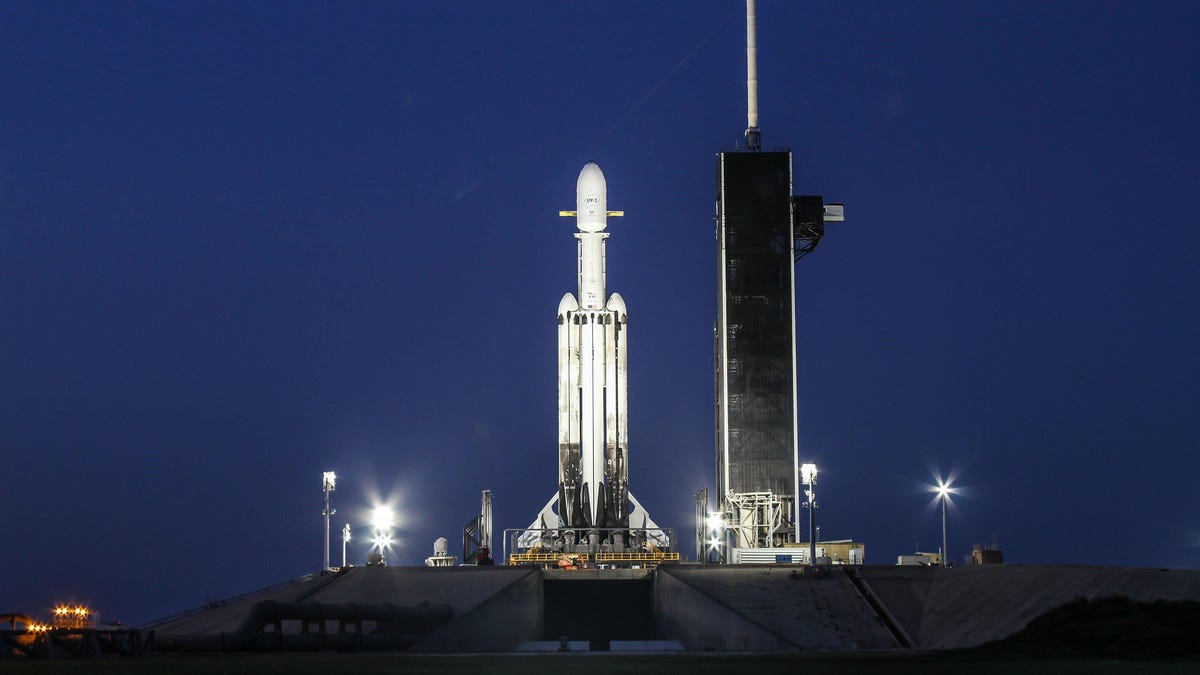Watch SpaceX attempt Falcon Heavy's 'most difficult launch ever' tonight
The Falcon Heavy rocket is scheduled for its first nighttime launch tonight, and the STP-2 mission is its most challenging yet.

SpaceX Falcon Heavy on the launchpad for the STP-2 mission.
The most powerful rocket from Elon Musk's SpaceX is set to take to the skies once again. Falcon Heavy is scheduled for its first nighttime launch late on Monday, June 24 (Tuesday, June 25 in some places). This will be the rocket system's third flight and it marks a historic point in reusability for the Heavy, with the two side boosters being reused for the first time. By SpaceX's own admission, the launch will be among the most challenging in the company's history.
NASA, which has some payloads on board, will livestream the proceedings starting at 8 p.m. PT from Launch Complex 39A at the Kennedy Space Center in Florida. The actual launch window opens at 8:30 p.m. PT and will remain open for approximately four hours. The latest update from SpaceX suggests the launch will occur at 2:30 a.m. ET, which corresponds to a late kick-off for the West Coast at 11:30 p.m. PT.
Targeting T-0 of 2:30 a.m. EDT for Falcon Heavy launch of STP-2; team completed additional ground system checkouts. Vehicle and payload continue to look good
— SpaceX (@SpaceX) June 25, 2019
SpaceX has its own livestream webcast as well:
Currently, the weather conditions are 70% favorable and additional updates on the weather will be provided as Monday progresses, but if the launch doesn't go ahead as planned, a backup window will open at 8:30 p.m. PT on Tuesday, June 25.
SpaceX shared a scenic view of Falcon Heavy sitting upright on the launchpad on Monday.
Falcon Heavy and STP-2 are vertical on Launch Complex 39A. Tonight’s four-hour launch window opens at 11:30 p.m. EDT, or 3:30 UTC on June 25 → https://t.co/gtC39uBC7z pic.twitter.com/NTblKjmFxT
— SpaceX (@SpaceX) June 24, 2019
This mission, dubbed STP-2 for the Department of Defense's Space Test Program-2, is kind of like an UberPool for space companies. It will ferry a couple dozen satellites into orbit, including Lightsail 2, a solar-sail test mission promoted by science star Bill Nye. It will also carry a Deep Space Atomic Clock, which could be used to help spacecraft navigate to distant destinations, as well as a satellite that will test a new type of green propellant for NASA.
In addition, spaceflight company Celestis will send the cremated remains of 100 Earthlings, including Apollo 11 support astronaut Bill Pogue, into the cosmos.
"The STP-2 mission will be among the most challenging launches in SpaceX history," SpaceX said, citing four separate upper-stage engine burns, three separate deployment orbits and a total mission duration of over six hours. The final deployments will occur around 3.5 hours into the mission. For comparison, the last Falcon Heavy mission deployed its satellite just 34 minutes after launch.
"This will be our most difficult launch ever," founder Elon Musk tweeted.
SpaceX will attempt to land the side boosters on ground landing zones, and the center core on the Of Course I Still Love You droneship in the Atlantic Ocean. This will be the first time the side boosters have been reused in a Falcon Heavy launch -- so the stakes are relatively high.
This mission marks the first reuse of side boosters that flew on a previous Falcon Heavy mission pic.twitter.com/4Zl7miTQ24
— SpaceX (@SpaceX) June 22, 2019
SpaceX will be hoping to avoid a repeat of Falcon Heavy's second flight in April, in which the center core landed successfully on the droneship, but was lost due to rough sea conditions. SpaceX hopes to bring it safely home this time but due to the orbital requirements of the Heavy's payloads this will be an extremely difficult capture, with the core landing on the droneship over 768 miles from shore -- further away than ever before.
Originally published June 21.
Update June 23, 7:20 p.m. PT: Adds more background information.
Update June 24, 8:30 a.m. PT: Adds projected liftoff time.



